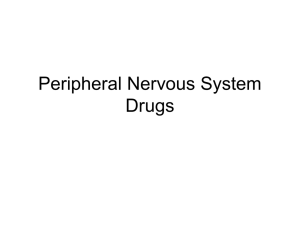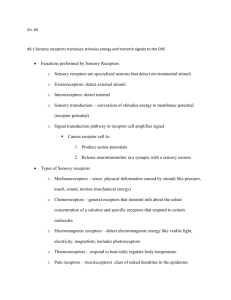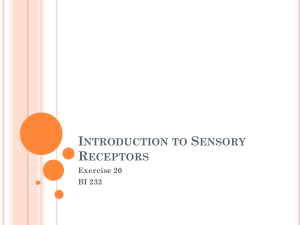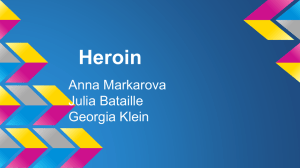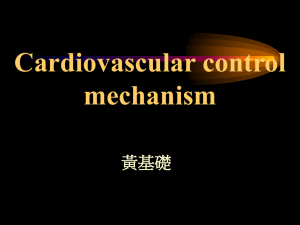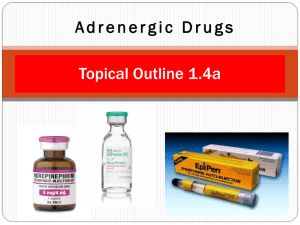Adrenergic System Lecture (2)
advertisement
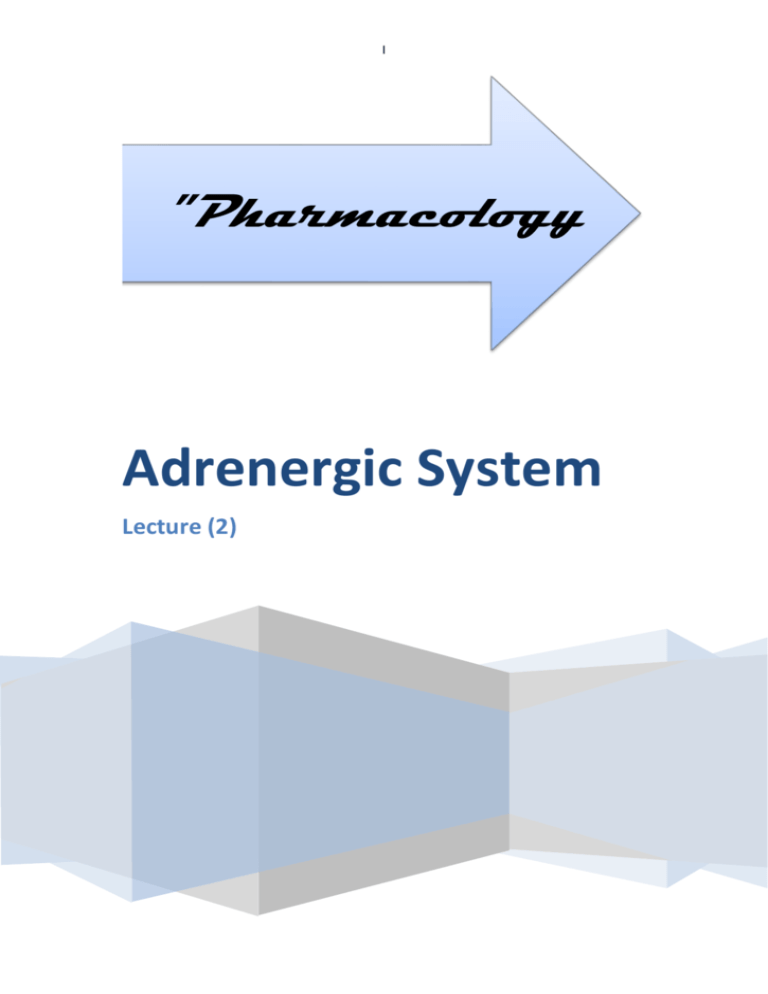
I "Pharmacology Adrenergic System Lecture (2) Beta Adrenoceptors: They're subdivided into three subtypes: Beta1, Beta2 and Beta3. 1) Beta1 receptors: Location 1) Heart Action *Increased Automaticity of SA node with increased heart rate( +ve chronotropic effect),increased Conductivity of AV node(+ve dromotropic effect), increased Excitability of AV node and muscles predispose to arrhythmias.increased Contractility of the myocardium(+ve inotropic effect) result in increased stroke volume and Cardiac output and work and increased Oxygen consumption. Decreased Refractory Period. 2) Kidney Stimulation of Beta1 receptors on juxtaglomerular cells will increase Renin release (Renin converts Angiotensinogen into Angiotensin I ) 3) Nerves Presynaptic adrenergic and cholinergic terminals. *: the action of Beta1 receptors in the heart is the followings: increased Automaticity of SA node with increased heart rate (i.e. positive chronotropic effect). Increased conductivity (velocity) in conducting tissues including AV node (i.e. positive dromotropic effect). Increased excitability of AV node and muscles. predisposing to arythmias. Increased contractility of myocardium (i.e. positive inotropic effect) resulting in increasing stroke volume increased cardiac output and work increased O2 consumption and decreased refractory period of all tissues. Page 2 2) Beta2 Receptors: Location 1) Blood Vessels Action Vasodilation of skeletal muscles, renal and visceral vessels. Decreased total peripheral resistance (TPR). 2) Lung Bronchodilation 3) GIT Smooth muscles in the intestinal wall are relaxed 4) Genitourinary system Relaxation of Bladder wall. Pregnant uterus relaxation delay of premature labour 5) Skeletal muscles Activation of Beta2 receptors Tremor and increased K+ by skeletal muscles Hypokalemia 6) Mast Cells Decreased Histamine release. 7) Liver Increased Gluconeogenesis and Glycogenolysis This will lead to Hyperglycemia. 8) Pancreas 9) Heart Increase release of Glucagon lead to Hyperglycemia Heart has beta2 but much lesser than other organs. Notes: Cardiac Stimulation is largely determined by Beta1 receptors and to lesser extent by Beta2 receptors. Ciliary muscles of eye have Beta Receptors( the subtype undetermined), their action isprobably relaxation.(not important) 3) Beta3 receptors: Were found recently in fat cells, their action is to enhance lipolysis. Page 3 Mechanism of Activation of Beta Receptors: Beta-receptor (all subtypes) Mediated by protein Gs Beta2 Smooth muscle phosphorylation of activation of adenyl cyclase Increase cAMP Myosin light chain kinase to an inactive Form Beta1 (heart) Increase the influx of Calcium - Activation of all subtypes of Beta receptors lead to activation of adenyl cyclase and this will lead to increased conversion of ATP to cAMP, both are mediated by protein Gs (stimulatory). - cAMP is the major 2nd messenger of beta receptor activation. - In the heart, the activation of beta receptors increased influx of calcium across cell membrane and its sequestration from sarcoplasmic reticulum inside the cell. - Relaxation of smooth muscle may involve the Phosphorylation (inactivation) of myosin light chain kinase. Beta activation increase cAMP Phosphorylation of myosin light chain kinase inactive form vasodilation and relaxation Nitrate increase cGMP dephosphorylation of myosin light chain kinase inactive form relaxation. Page 4 Dopamine Receptors: They're of 5 subtypes arranged in two families: Family (1) D1 and D5 Family (2) D2, D3 and D4 Stimulation of D1 family stimulation of adenyl cyclase smooth muscle relaxation renal vessels dilation Stimulation of D2 family inhibit adenylyl cyclaes and open potassium channels modulate transmitter release Desensitization of Receptors: Happens due to prolonged exposure to catecholamines reduces responsivity. It is also known as tachyphylaxis or tolerance. Three mechanisms explain this phenomenon and they function over hours or days: 1) Sequestration of the receptor 2) Down-Regulation 3) Inability to couple to G-protein because the receptor has been phosphorylated on the cytoplasmic side by eitherof protein kinase A or beta adrenergic receptor kinase (BARK). Supersensitivity:occure when there is: 1) Depletion of Noradrenaline in synaptic cleft by receptors 2) Cut off adrenergic nerve supply (de-innervation) 3) Up-regulation.:this happens when someone used to take a drug for a while this will increase the no of receptors to that drug then when suddenly he stops using that drug the effect will be much greater than before even before he began to use the drug. To avoid such cases we're "Tapering" the drug. I.e. gradually decrease the doses till stopping the drug. Page 5 Adrenergic Agonists: I. II. III. According to chemical structure. According to receptor sensitivity. According to their mode of action. According to chemical structure: 1) Catecholamine They're sympathomimitic amine that contains 3,4-dihydroxybenzene group like adrenaline, Noradrenaline, dopamine, Dobutamine and Isoprenaline. Both Dobutamine and Isoprenaline are synthetic. 1) 2) 3) 4) Characteristics: Show the highest potency. Shortest half-life in pharmacology (2 min) Do not readily penetrate into CNS. Metabolized by COMT (postsynaptically and in the gut wall), MAO (intraneuronally in the mitochondria of liver cells and gut wall cells). 5) They're ineffective if given orally except Isoprenaline. 2) Non-Catecholamine: They're phenylisopropylamines compounds lack the catechol hydroxyl groups, They include: phenylphrine, ephedrine and amphetamine group. Characteristics: 1) Not metabolized by COMT and they're poor substrates for MAO so they are given ORALLY. 2) Have prolonged duration of action. 3) Have increased lipid solubility. 4) Have greater access to CNS due to lipid solubility and they may act indirectly producing unwanted side effects. Page 6 According to receptor sensitivity: 1) Alpha-agonist. 2) Beta-agonist. According to their mode of action: 1) Direct acting agonists. Ex: (catecholamine and phenylephrine). These drugs act directly on alpha and beta receptors. 2) Indirectly acting agonists. Ex: (Amphetamine, Tyramine). Tyramine found in cheese, chocolate and beer, it's one of the sympathomimitics that act indirectly. It interacts with MAO inhibitors causing hypertensive crisis. These drugs are taken up into Presynaptic neurons and cause the release of NA from cytoplasmic pool or vesicles of adrenergic neuron. 3) Mixed action some agonist have both modes of action, they can directly stimulate Adrenoceptors and release NA from adrenergic neurons (indirect action). Ex: Ephedrine (mainly direct) Metaraminol (mainly indirect) Effect of Adrenergic Agonists: depends on: 1) Selectivity of drug or Affinity of the receptor. 2) Dose of the drug. 3) Homeostatic reflexes: The most important one is the baroreceptors reflex which is mediated by the stretch receptors located in the carotid sinus, aortic arch and atrium. Drop of Blood Pressure Reduce Stretch of baroreceptors reduced afferent impulses to the medulla oblongata production of efferent reflex via ANS Page 7 inhibition of parasympathetic and activation of sympathetic nervous system increase TPR and increase cardiac output Increase Blood Pressures Catecholamine: Noradrenaline: Mainly affects alpha receptors. Has weak effect on Beta1 receptors Has no effect on Beta2 receptors. So action on alpha1 = alpha2 and beta1 >> beta2 Adrenaline: Interacts with both alpha and beta receptors At low doses: Beta effect (vasodilation) on the vascular system predominates. At Higher doses: Alpha effect (vasoconstriction) is strongest. So action on alpha1 = alpha2 and beta1 = beta2 Isoprenaline: Predominantly stimulated beta adrenergic receptors, it's action on alpha receptors is insignificant. So; beta1 = beta2 >>>>>>>> alpha Page 8
